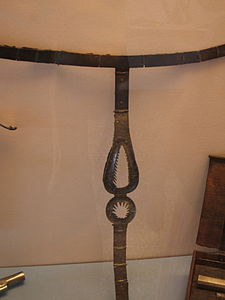- Chastity belt
-
A chastity belt is a locking item of clothing designed to prevent sexual intercourse. They may be used to protect the wearer from rape or temptation. Some devices have been designed with additional features to prevent masturbation. Chastity belts have been created for males and females, ostensibly for the purpose of chastity.
The term "chastity belt" is also used as a metaphor in modern English to imply overprotectiveness. The term carries a derisive connotation and may also imply that the subject is antiquated, or is cumbersome, or provides unnecessary or unwanted protection.
According to modern myths the chastity belt was used as an anti-temptation device during the Crusades. When the knight left for the Holy Lands on the Crusades, his Lady would wear a chastity belt to preserve her faithfulness to him. However, there is no credible evidence that chastity belts existed before the 15th century (more than one hundred years after the last Crusade), and their main period of apparent use falls within the Renaissance rather than the Middle Ages.
In any case, Renaissance chastity belts were said to have had padded linings (to prevent large areas of metal from coming into direct prolonged contact with the skin), and these had to be changed fairly frequently, so that such belts were not practical for uninterrupted long-term wear. Uninterrupted long-term wear could have caused genitourinary infection, abrasive wounds, sepsis and eventual death.[1]
Contents
Historical usage
According to one fictional account, Semiramis, a mythical Assyrian queen, was afraid that the women of the household would seduce her son, so she forced them to wear locked chastity belts.[2]
Gregory the Great, Alcuin of York, Bernard of Clairvaux and Nicholas Gorranus all made passing references to 'chastity belts' within their exhortatory and public discourses, but meant this in a figurative or metaphorical sense within their historical context.[3]
The first detailed actual mention of what could be interpreted as "chastity belts" in the West is in Konrad Kyeser von Eichstätt's Bellifortis (1405), which describes the military technology of the era. The book includes a drawing that is accompanied by the Latin text: "Est florentinarum hoc bracile dominarum ferreum et durum ab antea sic reseratum." ("These are hard iron breeches of Florentine women which are closed at the front.") The belt in this drawing is described by Dingwall as "both clumsy and heavy", having "little in common with the later models which served the same use".[4] The Bellifortis account is not supported by any additional concrete evidence or corroborating documents. Polidoro argues that Keyser's references are meant to be humorous or ironic, and that Dingwall's accounts of the use of chastity belts by a few rich men in the 16th and 16th centuries to ensure the faithfulness of their often much younger wives should be treated critically, due to the absence of actual artefacts of this nature from the historical period in question, and his lack of access to more detailed contemporary historical records.[3]
In 1889, a leather-and-iron belt was found by Anton Pachinger—a German collector of antiquities—in Linz, Austria in a grave on a skeleton of a young woman. The woman was reportedly buried sometime in the 16th century. Pachinger, however, could not find any record of the woman's burial in the town archives. The belt itself, along with most of the rest of Pachinger's collection, has been lost.[4]
Two belts have been exhibited at the Musée de Cluny in Paris. The first, a simple velvet-covered hoop and plate of iron, was supposedly worn by Catherine de' Medici. The other—said to have been worn by Anna of Austria—is a hinged pair of plates held about the waist by metal straps, featuring intricately etched figures of Adam and Eve.[4] There are other such belts at the Germanisches National museum in Nuremberg and the British Museum in London. Most have been removed from display to avoid any further embarrassment because the authenticity of these belts as medieval devices has since been called into question. Many contemporary historians accept that these alleged "artifacts" date from the nineteenth century, and are thus inauthentic.[5]
From the eighteenth century and until the thirties, masturbation was widely regarded as harmful in Western medicine. Numerous mentions can be found in medical journals of the time of the use of chastity belt-like devices to prevent masturbation in children and adolescents.[6] Many designs for anti-masturbation devices were filed in the US Patent Office until the early 1930s, when masturbation was deemed not to be the cause of mental health problems. [7]
Furthermore, some nineteenth century working women may have used them for protective reasons, as a 'rape shield" to obstruct sexual assault from predatory bosses or male work colleagues. They were not worn for a long time uninterruptedly, however, since sanitary and hygiene reasons prevented this before the modern invention of stainless-steel belts.[3]
Use in BDSM
Today, chastity belts are sometimes used in BDSM play and in consensual relationships. They are a means for the wearer to surrender control over their sexual behavior either for sexual play, or as a long-term method of preventing infidelity or masturbation. They range from simple leather or plastic toys commonly sold by adult stores to expensive high-security stainless steel devices made by a handful of specialist firms.
Recent developments
In 1998, racial riots against the ethnic Chinese in West Java prompted the production and sale of "anti-rape corsets". These were Florentine-type belts of imitation leather-covered plastic, fastened with a combination lock. The belts had a solid crotch strap without holes, and were intended only for brief outings.[8]
In April, 2002, the Uwe Koetter Jewellers company of Cape Town, South Africa completed and delivered a spectacular diamond and pearl-encrusted chastity belt made of gold to a British customer. The belt reportedly cost R160,000 and was a wedding gift from a husband-to-be for his bride to wear at their wedding.[9]
On February 6, 2004, USA Today reported that at Athens airport in Greece, a woman's steel chastity belt had triggered a security alarm at the metal detector. The woman explained that her husband had forced her to wear the device to prevent an extramarital affair while she was on vacation in Greece. She was allowed to continue her flight to London on the pilot's authority. The incident was said to have happened just before Christmas in 2003.[10] The incident was also reported by Weekly World News.[11]
In November 2006, photographs of Lucio Gubbio's hand-wrought iron chastity belts were published in newspapers including the Seoul Times,[12] and CRI Online.[13] Although Gubbio's company, MedioEvo, claims that their chastity belts' designs are from the Middle Ages on their website, a company spokesperson acknowledged that there is no proof that devices such as these were actually used.
In 2007, the Asian Human Rights Commission reported that women were being forced to wear chastity belts in the Indian state of Rajasthan.[14]
In 2008, masseuses in Batu, Indonesia were required to wear belts with a lock and key during working hours, to prevent prostitution.[15]
On February 8, 2010, AOL News reported that Dexter Blanch, a dog breeder from Louisiana, introduced a chastity belt for dogs, called PABS (Pet Anti-Breeding System). It is made of polypropylene and uses an eight-buckle locking system and a washable mesh pad to prevent intercourse in female dogs. Dr. Kathleen Makolinski, director of veterinary outreach at the ASPCA, commented that "For the majority of animals, spaying and neutering remains the most beneficial option".[16]
See also
- Anti-rape device
- Chastity belt (BDSM)
- Chastity piercing
- Erotic sexual denial
- Purity ring
- Sexual abstinence
References
Notes
- ^ Massimo Polidoro: "Myth of the Chastity Belts" Skeptical Inquirer: 35:5: September/October 2011: 27-28
- ^ Boccaccio, Giovanni; Brown, Virginia (2001). Famous women. p. 11. ISBN 9780674011304. http://books.google.com/books?id=3Nj04ULC0s8C&pg=PA11#v=onepage&q&f=false.
- ^ a b c Polidoro, 2011: 27-28
- ^ a b c Dingwall, Eric J (1931). The Girdle of Chastity: A Medico-Historical Study. Routledge. http://www.tpe.com/~altarboy/girdle.htm
- ^ "Two historians say chastity belts are purely medieval myths". Houston Chronicle: p. 22. 23 June 1996. http://www.chron.com/CDA/archives/archive.mpl?id=1996_1349429.
- ^ Stengers, Jean; van Neck, Anne (2001). Masturbation: the history of a great terror. Palgrave. ISBN 0-312-22443-5.
- ^ Bullough, Vern (1987). "Technology for the Prevention of 'les maladies produites par la masturbation". Technology and Culture (Johns Hopkins University Press) 28 (4): 828–832. doi:10.2307/3105184. JSTOR 3105184. PMID 11612372
- ^ Henderson, Peter (2000-07-11). "I Wear A Chastity Belt". Australian Cosmopolitan Magazine. Archived from the original on 2000-07-11. http://web.archive.org/web/20000711042724/http://www.tpe.com/~altarboy/nt000625.htm.
- ^ Cole, Barbara (12 May 2002). "Chastity belt-maker zips lips at Durban show". The Mercury. http://www.int.iol.co.za/index.php?set_id=1&click_id=13&art_id=ct20020512214730830C300638.
- ^ "Woman's chastity belt set off airport security alarm". USA Today (Athens). 6 February 2004. http://usatoday.com/travel/news/2004-02-06-chastity-belt_x.htm.
- ^ "Gal's chastity belt triggers airport metal detector". Weekly World News. 23 October 2004.
- ^ "Photo News: Medieval Chastity Belt". The Seoul Times. 18 November 2006. http://theseoultimes.com/ST/photo_gallery/photo_gallery.php?name=Photo_News&code=20061118-00300&page=24.
- ^ "意大利工匠打造贞操带 (Italian artisans to build chastity belt)" (in Chinese). CRI Online. 17 November 2006. http://gb.cri.cn/11344/2006/11/17/664@1307814.htm.
- ^ "INDIA: Forcing women to wear a chastity belt is a common practice in Rajasthan" (Press release). Asian Human Rights Commission. August 3, 2007. http://www.ahrchk.net/statements/mainfile.php/2007statements/1139/. Retrieved 10 June 2010.
- ^ "The return of the chastity belt". The Observers (Indonesia: France 24). 2008-04-29. http://observers.france24.com/en/content/20080429-indonesian-masseuses-forced-lock-trousers. Retrieved 10 June 2010.[dead link]
- ^ Wolf, Buck (8 February 2010). "Ruff Sex: A Chastity Belt for Dogs". AOL News. http://www.aolnews.com/2010/02/08/ruff-sex-a-chastity-belt-for-dogs/. Retrieved 2 April 2011.
Sources
- Bonneau, Alcide (1892) Padlocks and Girdles of Chastity: An historical and descriptive notice. Paris: Isidore Lideux. ISBN 1-58963-347-4. (Reprinted in 1932 and later by New York: Golden Hind Press and , New York: Big Dollar Books, and others.) Translation of Les cadenas et ceintures de chasteté. (The first half of the book is a dubious historical overview of chastity belts and their use by Greeks, Romans and others. The second half of the book is titled "Speech of Monsieur Freydier's on behalf of Mademoiselle Marie Lajon versus Sieur Pierre Berlhe, prisoner of the Court", in which Mlle. Lajon's counsel argues to have the Court order a chastity belt removed from her.)
Further reading
- Eric John Dingwall: The Girdle of Chastity: A Medico-Historical Study: London: Routledge and Sons: 1931.
- Massimo Polidoro: "The Myth of Chastity Belts": Skeptical Inquirer: 35: 5: September/October 2011: 27-28.
External links
Categories:- BDSM equipment
- Physical restraint
- Sexual abstinence
- Underwear
Wikimedia Foundation. 2010.




